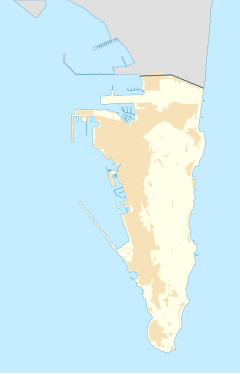Jews' Gate Cemetery
| Location of Jews' Gate Cemetery in Gibraltar | |
| Details | |
|---|---|
| Established | 1746 |
| Location | Gibraltar |
| Coordinates | 36°07′14″N 5°20′43″W / 36.1205°N 5.3454°W |
| Type | Jewish |
Jews' Gate Cemetery is a Jewish cemetery located on Windmill Hill within a nature reserve in the British Overseas Territory of Gibraltar. Also known as the Windmill Hill Cemetery, it is the site of the earliest known Jewish burials in Gibraltar. The cemetery opened by 1746 and closed in 1848. It is the burial site of a number of Gibraltar's Chief Rabbis. The graveyard is protected by the law of Gibraltar.
Jews' Gate Cemetery, also known as the Windmill Hill Cemetery, is located on Windmill Hill near the southern entrance to the Upper Rock Nature Reserve on the Rock of Gibraltar. It is positioned along Queen's Road, southeast of its junction with Engineer Road. That is also the location of the Pillars of Hercules Monument which depicts "The Ancient World" (see below). The earliest known Jewish burials in Gibraltar are located within the cemetery and date back to 1746. The cemetery closed for burials on 6 May 1848. A letter dated 31 May 1848 from the Colonial Secretary indicated that: "The Governor has given conclusive orders that no more interments shall take place at the former Burial Ground above Wind Mill Hill but that all future Hebrew dead shall be deposited in the allotted portion of the New Cemetery."
The reason for this location for burials of members of the Jewish community is uncertain. One theory is that the more visible and accessible cemetery utilised by Christians, near the border with Spain, was more subject to the laws regarding expulsion of Jews, which had been mandated by the 1713 Treaty of Utrecht. The best-preserved gravestones at Jews' Gate Cemetery are those that, until recently, were protected by a layer of mud and peat. The inscriptions on the limestone tombstones that have been exposed to the elements have become difficult to decipher. During half of the year, the winter and spring, plants are allowed to grow freely in the cemetery, in deference to the Gibraltar Ornithological and Natural History Society. The area is a favoured mating and nesting ground of the Barbary partridge; after their nesting season, the cemetery is cleared and the impression of neglect is removed.
...
Wikipedia

